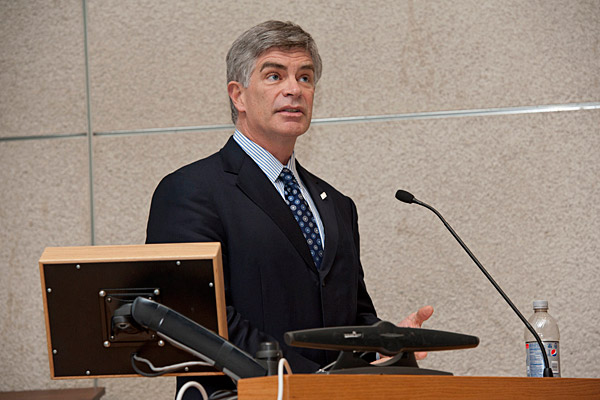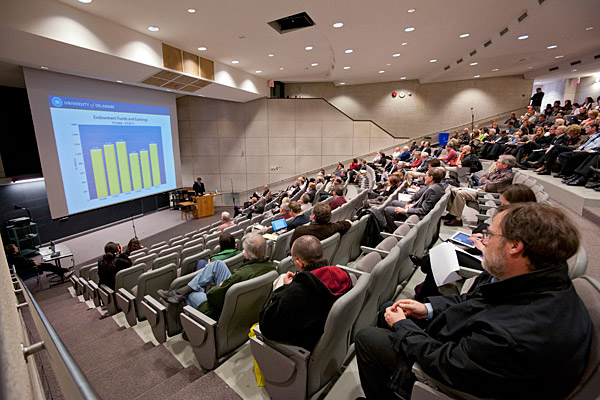Budget challenges
President Harker discusses UD budget during open meeting
3:15 p.m., Feb. 14, 2012--Meeting budgetary challenges in a time of economic downturn and increased pressure on institutional revenues and expenses led the list of topics discussed by University of Delaware President Patrick Harker during an open meeting, held Monday, Feb. 13, in Smith Hall.
Harker’s entire speech and presentation can be found on the Speeches page at the Office of the President website.
Campus Stories
From graduates, faculty
Doctoral hooding
Introduced by Sheldon Pollack, Faculty Senate president-elect and professor of legal studies in the Alfred Lerner College of Business and Economics, Harker told the audience of more than 250 UD community members that while the University’s budget situation is favorable compared to that of its comparator institutions (see Benchmarking at UD below), significant challenges must be addressed if UD is to continue to meet the goals set out in its Path to Prominence strategic plan.
Challenges include state appropriations that are down from historical levels and the funding of student aid programs, including the Commitment to Delawareans, which currently provides financial aid to 40 percent of UD’s in-state freshmen, sophomores and juniors.
“State support to UD now comprises less than 12 percent of our operating budget, compared to pre-recession funding that supplied more than 17 percent,” Harker said. “But, given the fiscal challenges the state faces, I am grateful for the governor’s recommendation last month that the total appropriation to the University for next fiscal year remains the same as this year.”
Harker also noted that the University was looking at models for a more modest tuition increase in FY 2013 compared to those in recent years.
“We have to give students and families a break,” Harker said. “We have to be cognizant that increasing tuition precipitates a closely correlated increase in student aid.”
Projections for reduced federal grant appropriations in 2012 and a flat line in 2013 reflect the ending of stimulus funding and the federal government’s tough budget situation, Harker said.
Additional budgetary pressures cited by Harker include:
- An average increase in health care costs of 6.3 percent per year over the past four years;
- A 4.6 percent annual growth in utility costs; and
- Retirement cost increases of 3.8 percent annually.
“These pressures aren’t new, and over the last few years we’ve had to make some difficult decisions because of them,” Harker said. “Balancing our budget, not just in the short term but over the long term, too, will depend on us containing these expenditures.”
Recent cost-saving measures adopted by UD have included a 2.9 percent cut to the basic budget for 2010 and three straight years of administrative cuts, which have resulted in a 10 percent reduction in all non-college budgets, Harker said.
While UD has been vigilant in committing resources to its highest priorities -- students and college programs -- Harker said significant challenges remain for the next fiscal year.
“Despite the difficult economy, UD’s colleges and administrative units have forged ahead on the Path to Prominence, making strategic investments in the resources and assets that will allow the University to thrive. Given the state of the national economy, the investments we have made, the budgetary pressures we’ve felt and our expenditure obligations, when we refined our budget projections for next year we forecasted an FY 2013 budget shortfall between $15 million and $25 million,” Harker said. “We have large reserves, but we can’t fund operations out of our reserves. We need to fund out of revenue.”
Harker added that a Budget Working Group convened last fall has been reviewing the University’s financial plan for FY 2013 and has recommended measures to eliminate the projected budget gap.
The Budget Working Group used the following set of principles to analyze specific non-college budgets in its deliberations:
- Encourage innovation and efficiency by eliminating duplicative services and programs in low demand;
- Preserve the core of services and retain UD's ability to attract and keep great faculty, staff and students;
- Measure reductions against their impact on students, faculty and staff, and overall legal and enterprise risk to the University;
- Avoid reductions that impede the costs of another unit and provide flexibility for the implementation of cost-savings ideas; and
- Focus on the short and long term by investing in areas of strategic importance, implementing revenue-generating ideas and reducing costs that are expected to continue growing.
“We’re looking at our core revenue drivers -- tuition, state appropriations, gifts, contract and grants, endowment and investment income -- and forecasting what we can expect from them in this coming year,” Harker said. “That revenue is competing against significant expenses that include employment costs of salary, health care and pensions, plus financial aid, utilities and capital maintenance.”
Recommendations include managing salary and employment costs, reducing operational administrative budgets, driving down mandated costs and delaying the growth of key investments, Harker said.
While the University’s budget is not in crisis, Harker reemphasized that UD has a finite resource pool and will have to be diligent in cutting costs.
“The challenge before us today is one of budget, of controlling costs and continuing to make UD affordable and competitive over the short and long terms,” Harker said. “We’ll do this by maintaining our focus on the sound financial management principles that won us a AA+ bond rating.”
Harker said he expects that financial pressure on the higher education sector nationally and locally will continue to challenge UD, and that the University’s reliance on significant state and private support and on tuition will require vigilance in the annual budgeting process and in making long-term strategic decisions. The University community, he said, must realize benefits from the savings and gains already achieved, pursue additional revenue streams and take advantage of opportunities to invest in academic and research programs while delivering services at lower cost and with higher quality. “I encourage faculty and staff to communicate with their deans and vice presidents, who will continue to manage limited resources efficiently and effectively in the future,” Harker said. “Our budget recommendations and decisions today set a direction that will guide UD in the coming fiscal year and beyond.”
“Throughout this economic downturn, there’s no doubt we’ve fared much better financially than many other universities. That said, we’ll need to continue to find ways to innovate and create efficiencies,” Harker said. “What we won’t do is abandon our ambitions, detour from our path or undervalue our students, faculty and staff, the very people who, every day, make this University as great as it is.”
Following the discussion, Harker fielded audience questions on a wide range of topics, including large versus small class sizes, responsibility based budgeting as an aid for academic decision-making, specific roles faculty and others can take in fostering development and alumni loyalty and the important relationship between research and teaching.
Benchmarking at UD
Benchmarking UD with comparator institutions informs strategic decision-making and policy formulation at the University for both academic and administrative units. Benchmarking exercises highlight the University’s present strengths, weaknesses, opportunities and challenges. These exercises also allow realistic goals to be set and a means to monitor progress being made to attain such goals. The current list of comparator institutions is a combination of UD actual and aspirational peer institutions resulting from a peer cluster analysis performed by the Office of Institutional Research. Institutional descriptors such as full- and part-time enrollment, full-time faculty, freshman retention rate, undergraduate degrees as percentage of total degrees, six-year graduation rate, revenue from tuition, revenue from endowment, expenditures on instruction, expenditures on research and alumni giving percentage were used to identify institutions.
UD Comparator Institutions
Boston College
Brown University
Carnegie Mellon University
College of William and Mary
Georgia Institute of Technology
Lehigh University
Pennsylvania State University
University of Maryland - College Park
University of North Carolina-Chapel Hill
University of Notre Dame
University of Pittsburgh - Main Campus
University of Virginia
Article by Jerry Rhodes
Photos by Evan Krape












